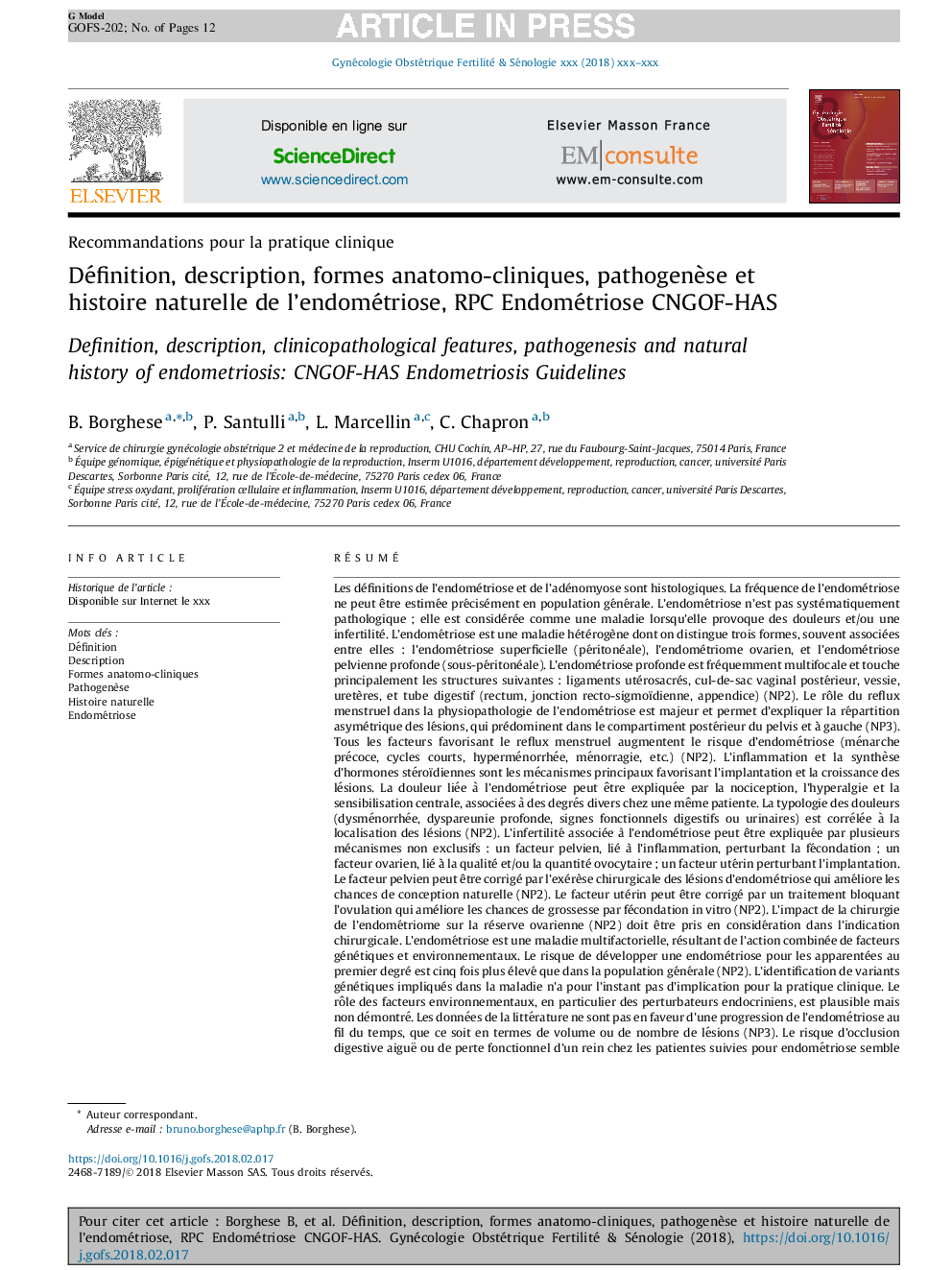| کد مقاله | کد نشریه | سال انتشار | مقاله انگلیسی | نسخه تمام متن |
|---|---|---|---|---|
| 8926246 | 1643667 | 2018 | 12 صفحه PDF | دانلود رایگان |
عنوان انگلیسی مقاله ISI
Définition, description, formes anatomo-cliniques, pathogenèse et histoire naturelle de l'endométriose, RPC Endométriose CNGOF-HAS
دانلود مقاله + سفارش ترجمه
دانلود مقاله ISI انگلیسی
رایگان برای ایرانیان
کلمات کلیدی
موضوعات مرتبط
علوم پزشکی و سلامت
پزشکی و دندانپزشکی
زنان، زایمان و بهداشت زنان
پیش نمایش صفحه اول مقاله

چکیده انگلیسی
Endometriosis and adenomyosis are histologically defined. The frequency of endometriosis cannot be precisely estimated in the general population. Endometriosis is considered a disease when it causes pain and/or infertility. Endometriosis is a heterogeneous disease with three well-recognized subtypes that are often associated with each other: superficial endometriosis (SUP), ovarian endometrioma (OMA), and deep infiltrating endometriosis (DIE). DIE is frequently multifocal and mainly affects the following structures: the uterosacral ligaments, the posterior vaginal cul-de-sac, the bladder, the ureters, and the digestive tract (rectum, recto-sigmoid junction, appendix). The role of menstrual reflux in the pathophysiology of endometriosis is major and explains the asymmetric distribution of lesions, which predominate in the posterior compartment of the pelvis and on the left (NP3). All factors favoring menstrual reflux increase the risk of endometriosis (early menarche, short cycles, AUB, etc.). Inflammation and biosteroid hormones synthesis are the main mechanisms favoring the implantation and the growth of the lesions. Pain associated with endometriosis can be explained by nociception, hyperalgia, and central sensitization, associated to varying degrees in a single patient. Typology of pain (dysmenorrhea, deep dyspareunia, digestive or urinary symptoms) is correlated with the location of the lesions. Infertility associated with endometriosis can be explained by several non-exclusive mechanisms: a pelvic factor (inflammation), disrupting natural fertilization; an ovarian factor, related to oocyte quality and/or quantity; a uterine factor disrupting implantation. The pelvic factor can be fixed by surgical excision of the lesions that improves the chance of natural conception (NP2). The uterine factor can be corrected by an ovulation-blocking treatment that improves the chances of getting pregnant by in vitro fertilization (NP2). The impact of endometrioma exeresis on the ovarian reserve (NP2) should be considered when a surgery is scheduled. Endometriosis is a multifactorial disease, resulting from combined action of genetic and environmental factors. The risk of developing endometriosis for a first-degree relative is five times higher than in the general population (NP2). Identification of genetic variants involved in the disease has no implication for clinical practice for the moment. The role of environmental factors, particularly endocrine disrupters, is plausible but not demonstrated. Literature review does not support the progression of endometriosis over time, either in terms of the volume or the number of the lesions (NP3). The risk of acute digestive occlusion or functional loss of a kidney in patients followed for endometriosis seems exceptional. These complications were revealing the disease in the majority of cases. IVF does not increase the intensity of pain associated with endometriosis (NP2). There is few data on the influence of pregnancy on the lesions, except the possibility of a decidualization of the lesions that may give them a suspicious aspect on imaging. The impact of endometriosis on pregnancy is debated. There is an epidemiological association between endometriosis and rare subtypes of ovarian cancer (endometrioid and clear cell carcinomas) (NP2). However, the relative risk is moderate (around 1.3) (NP2) and the causal relationship between endometriosis and ovarian cancer is not demonstrated so far. Considering the low incidence of endometriosis-associated ovarian cancer, there is no argument to propose a screening or a risk reducing strategy for the patients.
ناشر
Database: Elsevier - ScienceDirect (ساینس دایرکت)
Journal: Gynécologie Obstétrique Fertilité & Sénologie - Volume 46, Issue 3, March 2018, Pages 156-167
Journal: Gynécologie Obstétrique Fertilité & Sénologie - Volume 46, Issue 3, March 2018, Pages 156-167
نویسندگان
B. Borghese, P. Santulli, L. Marcellin, C. Chapron,